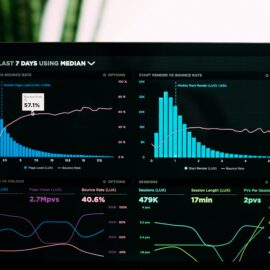
This is a free excerpt from one of Shortform’s Articles. We give you all the important information you need to know about current events and more.
Don't miss out on the whole story. Sign up for a free trial here .
How big is AI’s carbon footprint? How fast is it growing? Can anything be done to curb it?
AI’s carbon footprint and energy use are growing rapidly and could undermine global climate change goals. Mitigating AI’s emissions will require a combination of corporate carbon reduction commitments, AI efficiency improvements, a shift to renewable energy, and government regulation.
Continue reading to learn how the growth of AI is affecting the environment.
AI’s Carbon Footprint Is Growing Quickly
AI language models like ChatGPT rely on vast networks of energy-intensive computer servers and hardware to operate. These systems consume significant electricity, leading to substantial carbon emissions and a sizable carbon footprint.
Carbon footprints are important because carbon emissions are a key contributor to the greenhouse effect, which traps heat in the Earth’s atmosphere and accelerates climate change. And, although AI currently accounts for less than 1% of total carbon emissions, the AI market is predicted to expand ninefold by 2030.
Spotty AI Emissions Reporting
Virtually no data exists on carbon emissions generated by popular AI models like OpenAI’s ChatGPT. Experts say that major technology companies including Microsoft, Google, and IBM have long underreported their carbon emissions—even well before AI’s rise. Nevertheless, some estimates of companies’ emissions do exist:
- Training complex AI models like ChatGPT releases an estimated 500 tons of carbon into the atmosphere—equal to over 600 roundtrip flights between New York and London.
- Training Google’s LaMDA model produces an estimated 26 tons of carbon dioxide—roughly the same as the emissions of 22 passengers on a round-trip flight from New York to San Francisco.
- Hugging Face estimates that the carbon footprint of its AI technology, BLOOM, is roughly the same as 60 flights between New York and London.
The Problem With AI’s Carbon Footprint
Tech workers, researchers, and environmentalists warn that without a rapid, radical shift in AI system development that accounts for its environmental impact, the technology’s energy consumption will surpass that of the entire global workforce by 2025. At present:
- Training a single AI model can produce emissions equal to more than 626,000 pounds of carbon dioxide—roughly five times the emissions generated by the average American car during its lifetime.
- A single data center can use the same amount of electricity as 50,000 homes.
- The cloud’s carbon footprint now surpasses that of the entire airline industry.
As AI’s popularity and energy demands grow, so will its carbon footprint—potentially imperiling global climate goals.
Addressing AI’s Carbon Footprint
AI companies and researchers assert that AI emissions, while substantial, can be mitigated through a range of measures. Steps that tech companies are taking and exploring to address AI emissions include:
- Pledging to achieve carbon neutrality or negativity.
- Shifting to renewable energy sources such as wind and solar to power AI data centers.
- Relocating machine learning jobs to regions with more environmentally friendly carbon footprints.
- Enhancing the efficiency of data centers, chips, and algorithms.
AI Is Guzzling Water Too
On top of AI’s carbon footprint, AI systems like ChatGPT require vast amounts of computing power to analyze human language patterns and generate coherent text. This intensive process generates enormous heat that must be dissipated to prevent computer shutdowns. Data centers—the physical facilities that house servers and storage that underpin ChatGPT and other chatbots—frequently use water cooling systems to regulate temperatures. Water is the cheapest way to cool servers.
How Much Water Are AI Systems Using?
Experts say that historically, tech firms have declined to share details about their water consumption in individual centers, citing these data as trade secrets. A 2022 survey revealed that just 39% of data centers even monitored their water use—a 12% decrease from 2021.
However, companies like Miocrosoft and Google have begun sharing information about their water use recently, reporting 34% and 20% spikes in water consumption between 2021 and 2022—primarily to cool AI systems housed in data centers.
- Microsoft’s water use jumped 1.7 billion gallons in a single year—from 4,772,890 cubic meters to 6,399,415.
Google used 5.6 billion gallons of water last year—roughly the amount needed for 37 golf courses.
Looking Ahead
Some experts say that reducing AI’s carbon footprint depends on companies’ priorities in the coming years. Future AI models could be designed to be more energy-efficient than they are now, and companies could substantially reduce data centers’ energy use and emissions by optimizing resources such as location, type of power they use, and time of day they operate. Whether companies pursue these avenues vigorously remains to be seen.
Others caution that even with promises from companies like Microsoft, Google, and Meta to reduce AI carbon emissions through such changes, achieving their stated targets could take years.

Want to fast-track your learning? With Shortform, you’ll gain insights you won't find anywhere else .
Here's what you’ll get when you sign up for Shortform :
- Complicated ideas explained in simple and concise ways
- Smart analysis that connects what you’re reading to other key concepts
- Writing with zero fluff because we know how important your time is






